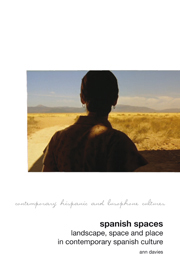Book contents
- Frontmatter
- Contents
- Acknowledgements
- List of illustrations
- 1 Introduction
- 2 Memory: landscapes of the past in Guillermo del Toro's Spanish films
- 3 Forgetting: the landscapes of Gonzalo Torrente Ballester
- 4 Landscape and identities in the Basque Country
- 5 Crime scene: landscape and the law of the land
- 6 Crime, scene, investigation: women, detection and the city
- 7 Coasting: tourism and landscape
- 8 Immigration: north (of) Africa
- 9 Conclusion
- Filmography
- Bibliography
- Index
5 - Crime scene: landscape and the law of the land
- Frontmatter
- Contents
- Acknowledgements
- List of illustrations
- 1 Introduction
- 2 Memory: landscapes of the past in Guillermo del Toro's Spanish films
- 3 Forgetting: the landscapes of Gonzalo Torrente Ballester
- 4 Landscape and identities in the Basque Country
- 5 Crime scene: landscape and the law of the land
- 6 Crime, scene, investigation: women, detection and the city
- 7 Coasting: tourism and landscape
- 8 Immigration: north (of) Africa
- 9 Conclusion
- Filmography
- Bibliography
- Index
Summary
This chapter and the next consider the links between the law and national identity, as further examples of the ways in which a notion of nation can trace itself through space and place. Space is one of the ideas listed by Tim Edensor in his discussion of the imbrications of legal frameworks, national identities and everyday life. ‘In a very practical sense, national identity is facilitated by the state's legislative framework, which delimits and regulates the practices in which people can partake, the spaces in which they are permitted to move, and in many other ways provides a framework for quotidian experience’ (Edensor 2002: 20). But more particularly space and place can become sites wherein the law is actively carried out (or, also, actively broken): the law is not simply an implicit shaper of daily experiences but something overtly manifested and displayed through policing and through criminal activity. And, as we shall see, the law is one manifestation of national identity, although not an unproblematic one precisely because the law and its policing by definition imply the possibility that the law can be broken and thus the link between law and nation fractured. But if the law is to this extent always provisional, it nonetheless offers the opportunity for the national to trace itself through textual space and place. The idea of the law, either broken or reinstated as part of the Spanish thriller, calls up once more Rose's desire for association and space and place as the means whereby we see that desire. The law’s constant re-making and re-breaking, and its link to national identity, suggest once more a Spain always in the process of becoming.
- Type
- Chapter
- Information
- Spanish SpacesLandscape, Space and Place in Contemporary Spanish Culture, pp. 82 - 100Publisher: Liverpool University PressPrint publication year: 2012

